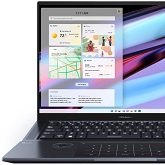
[ad_1]
 A few months ago, we tested one of the cheapest mobile devices certified by NVIDIA Studio, and therefore one that can be assigned to the category of mobile workstations. It was the ASUS Vivobook Pro 14X laptop, offering not only an excellent quality OLED screen, but also an unusual solution in the form of a virtual ASUS DialPad, integrated with the touchpad. Today, however, we would like to present a much more extensive device, with greater possibilities in terms of, for example, pure performance. We are talking about ASUS Zenbook Pro 16X, the latest representative in the Zenbook family. However, this is not a typical ultrabook, as tested so far. We are talking about a mobile workstation, characterized by i.a. tilting keyboard and physical ASUS DialPad.
A few months ago, we tested one of the cheapest mobile devices certified by NVIDIA Studio, and therefore one that can be assigned to the category of mobile workstations. It was the ASUS Vivobook Pro 14X laptop, offering not only an excellent quality OLED screen, but also an unusual solution in the form of a virtual ASUS DialPad, integrated with the touchpad. Today, however, we would like to present a much more extensive device, with greater possibilities in terms of, for example, pure performance. We are talking about ASUS Zenbook Pro 16X, the latest representative in the Zenbook family. However, this is not a typical ultrabook, as tested so far. We are talking about a mobile workstation, characterized by i.a. tilting keyboard and physical ASUS DialPad.
Author: Damian Marusiak
When I tested an ASUS laptop with a DialPad knob for the first time in February this year, then this solution was not yet very developed. Its capabilities were actually limited to the Adobe package and several system options, such as changing the screen brightness or volume level. When I started testing the latest Zenbook Pro 16X, I already received a more developed solution, the support of which extended not only to Adobe Creative Cloud applications, but also to programs from the Microsoft 365 (Office) package, and even to the Google Chrome web browser. ASUS DialPad in the current version makes more sense and is more practical, and the growing number of supported applications is a big advantage, because it makes the dial more than just a hardly practical novelty. The specification of the laptop itself is also quite good, although throughout the tests I felt disappointed that inside we will find only the NVIDIA GeForce RTX 3060 graphics chip, and not something stronger. There is potential in this device, but I feel that it will be developed only on the occasion of the premiere of the new generation of NVIDIA GeForce RTX 4000 systems from the Ada Lovelace family.
ASUS Zenbook Pro 16X is not only strong components, but also unique solutions in the design of the device itself. The tilting keyboard and the physical ASUS DialPad knob come to the fore.
NVIDIA Studio is a project that started with Computex 2019 in Taipei. The NVIDIA Studio platform combines RTX graphics cards, NVIDIA Studio software with specialized SDKs and dedicated Studio drivers. The platform undergoes rigorous hardware and software testing, including major creative applications. The entire project is co-created with notebook manufacturers who prepare devices that meet the requirements of the NVIDIA Studio platform. Laptops are based on GeForce RTX or Quadro RTX graphics chips and are compatible with dedicated NVIDIA Studio drivers. It is also worth mentioning that Studio drivers are not limited to Quadro RTX / RTX cards only. They can also be easily installed on consumer GeForce RTX cards and GTX 16 series (Turing) and GTX 10×0 (Pascal) systems. In this way, cards can also receive additional improvements.
The ASUS Zenbook Pro 16X notebook uses the new Intel Alder Lake-H processors, which are the second generation (in laptops) in which we find a hybrid x86 architecture. The 12th generation processors use two types of cores – Performance (Golden Cove architecture), where the core has been significantly rebuilt, introducing the biggest changes since the introduction of the x86 Skylake core (6th generation Intel Core). The Performance Cores are further aided by the more energy-efficient Efficient Cores – they offer IPC at the level of the x86 core from the 10th generation of Comet Lake, while drawing noticeably less power compared to large Performance cores. The tested model features a 14-core and 20-thread Intel Core i7-12700H processor with integrated Intel Iris Xe Graphics.
[ad_2]
![ASUS Zenbook Pro 16X Test - Mobile Workstation with Intel Core i7-12700H, NVIDIA GeForce RTX 3060 and tilt keyboard [nc1]](https://www.purepc.pl/image/artykul/2022/12/01_test_asus_zenbook_pro_16x_mobilna_stacja_robocza_z_intel_core_i7_12700h_nvidia_geforce_rtx_3060_i_z_odchylana_klawiatura_51.jpg)
![ASUS Zenbook Pro 16X Test - Mobile Workstation with Intel Core i7-12700H, NVIDIA GeForce RTX 3060 and tilt keyboard [nc1]](https://www.purepc.pl/image/artykul/2022/12/01_test_asus_zenbook_pro_16x_mobilna_stacja_robocza_z_intel_core_i7_12700h_nvidia_geforce_rtx_3060_i_z_odchylana_klawiatura_52.jpg)